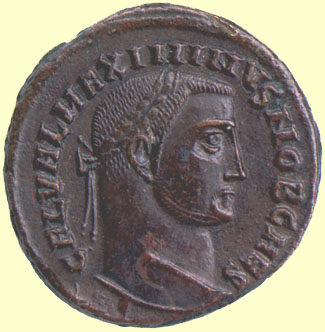 Contents -
Previous Article -
Next Article
Contents -
Previous Article -
Next Article
When the Roman Emperor Galerius ascended the throne upon the abdication of Diocletian and Maximianus, he appointed Maximinus Daia as his Caesar in the East to replace him. He remained Caesar until 308, when Galerius thought it prudent to promote him to the rank of Augustus. There had recently been a rebellion led by Maxentius, Maximianus, and Constantine that had thrown the Roman Empire back into the anarchy of civil war from which Diocletian had rescued them at the end of the Third Century. Severus II, Augustus in the West, had been defeated and murdered by Maxentius’ forces. To preserve the empire, Galerius had called a peace conference at the city of Carnuntum on the Danube. It was decided there to place Licinius I on the Western throne because he was a strong supporter of Galerius and Galerius believed he could trust him. Both Constantine and Maximinus were given the rank of Caesar. This angered both men, because Licinius had not served as Caesar before his elevation as Augustus, thus violating the system on which the original Tetrarchy was founded. Galerius appeased both Maximinus and Constantine by giving them the rank of Augustus early in the year 309.
In 311, Galerius died after a terrible illness and Maximinus became Emperor Maximinus II, sole Augustus in the East. He immediately moved his court to the city of Nicomedia in Asia Minor and governed from there.
In 312, Constantine made an alliance with Licinius and finally defeated Maxentius at the Milvian Bridge. Giving the credit for his victory to God, Constantine issued the Edict of Milan in 313. This law proclaimed that all people under Roman rule were free to worship whatever god they chose and would from that day forward be free from persecution. The Edict of Milan had no effect, however, in the East because Maximinus still actively persecuted the Christians in his dominions.
A short while later, Maximinus decided to invade territory belonging to Licinius. He captured several cities before Licinius was able to bring his armies from Milan to face him. Maximinus was defeated in the battle fought in Thrace on April 30, 313 and only escaped because he disguised himself as a slave. He died a few months later at Tarsus. There was nothing left of the old Tetrarchy now. Constantine was left in control of the West and Licinius was Augustus in the East. Both men later made their sons Caesars and the system by which a man was chosen on the basis of merit was discarded in favor of the time-honored dynastic system under which a man’s son inherited the throne from him.
Go to next article on Constantine I (The Great)
Go back to previous article on Emperor Severus II